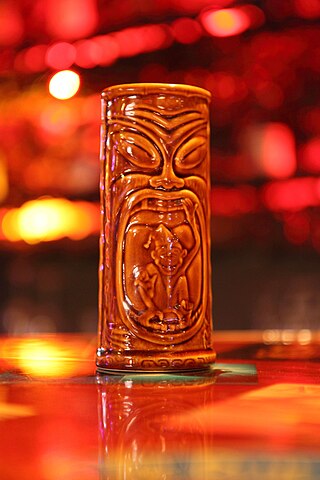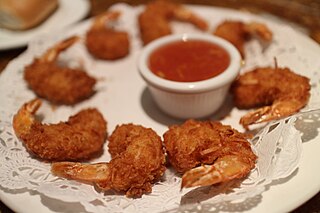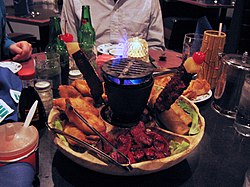
American Chinese cuisine is a cuisine derived from Chinese cuisine that was developed by Chinese Americans. The dishes served in many North American Chinese restaurants are adapted to American tastes and often differ significantly from those found in China.

Tiki culture is an American-originated art, music, and entertainment movement inspired by Polynesian, Melanesian, and Micronesian cultures, and by Oceanian art. Influential cultures to Tiki culture include Australasia, Melanesia, Micronesia, Polynesia, the Caribbean Islands, and Hawaii. The name comes from Tiki, the Māori name for the first human, often represented in the form of hei-tiki, a pendant and important taonga. The hei-tiki was often appropriated by Europeans as a commercialised good luck charm, hence the name of Tiki culture. Despite spanning over 10,000 miles and including many different unrelated cultures, religions, and languages, Tiki aesthetic is considered by some to be amalgamated into one "fantasia of trans-Pacific cultures" and "colonial nostalgia". Because of this, and the simplistic view of the Pacific taken by the aesthetic, Tiki culture has often proved controversial.
An hors d'oeuvre, appetiser or starter is a small dish served before a meal in European cuisine. Some hors d'oeuvres are served cold, others hot. Hors d'oeuvres may be served at the dinner table as a part of the meal, or they may be served before seating, such as at a reception or cocktail party. Formerly, hors d'oeuvres were also served between courses. There are two types of hors d'oeuvre from service point of view:
- General hors d'oeuvre
- Classical hors d'oeuvre

Satay, or sate in Indonesian spelling, is a Southeast Asian form of kebab made from seasoned, skewered and barbecued meat, served with a sauce.
Donn Beach was an American adventurer, businessman, and World War II veteran who was the "founding father" of tiki culture. He is known for opening the first prototypical tiki bar, Don the Beachcomber, during the 1930s in Hollywood, California, which was expanded to a chain of dozens of restaurants throughout the United States. He later built the International Market Place and additional establishments in what was then the Territory of Hawaii. He married three times.

Trader Vic's is a restaurant and tiki bar chain headquartered in Emeryville, California, United States. Victor Jules Bergeron, Jr. founded a chain of Polynesian-themed restaurants that bore his nickname, "Trader Vic". He was one of two people who claimed to have invented the Mai Tai. The other was his amicable competitor for many years, Donn Beach of the "Don the Beachcomber" restaurants.

Rijsttafel, a Dutch word that literally translates to "rice table", is an Indonesian elaborate meal adapted by the Dutch following the hidang presentation of nasi padang from the Padang region of West Sumatra. It consists of many side dishes served in small portions, accompanied by rice prepared in several different ways. Popular side dishes include egg rolls, sambals, satay, fish, fruit, vegetables, pickles, and nuts. In most areas where it is served, such as the Netherlands, and other areas of strong Dutch influence, it is known under its Dutch name.

The cuisine of Hawaii incorporates five distinct styles of food, reflecting the diverse food history of settlement and immigration in the Hawaiian Islands.

Filipino cuisine is composed of the cuisines of more than a hundred distinct ethnolinguistic groups found throughout the Philippine archipelago. A majority of mainstream Filipino dishes that compose Filipino cuisine are from the food traditions of various ethnolinguistic groups and tribes of the archipelago, including the Ilocano, Pangasinan, Kapampangan, Tagalog, Bicolano, Visayan, Chavacano, and Maranao ethnolinguistic groups. The dishes associated with these groups evolved over the centuries from a largely indigenous base shared with maritime Southeast Asia with varied influences from Chinese, Spanish, and American cuisines, in line with the major waves of influence that had enriched the cultures of the archipelago, and adapted using indigenous ingredients to meet local preferences.

A tiki mug is a large ceramic cocktail drinking vessel that originated in tiki bars and tropical-themed restaurants. The term "tiki mug" is a blanket term for the sculptural drinkware even though they vary in size and most do not contain handles. They typically depict Polynesian, mock-Polynesian, tropical, nautical, or retro themes, and as the term is used generically do not always emulate a tiki. When used to serve drinks they are frequently garnished with fruit or decorative drink umbrellas and swizzle sticks.

A tiki bar is a themed drinking establishment that serves elaborate cocktails, especially rum-based mixed drinks such as the Mai Tai and Zombie cocktails. Tiki bars are aesthetically defined by their tiki culture décor which is based upon a romanticized conception of tropical cultures, most commonly Polynesian. Some bars also incorporate general nautical themes or retro elements from the early atomic age.
Oysters en brochette is a classic dish in New Orleans Creole cuisine. Raw oysters are skewered, alternating with pieces of partially cooked bacon. The entire dish is then broiled or breaded then either deep fried or sautéed. The traditional presentation is on triangles of toast with the skewer removed and dusted with salt and pepper or topped with either Maitre d'Hotel butter or a Meunière sauce. When prepared well, the dish should have a crispy exterior and a soft savory center with a textural contrast between the bacon and the oyster. It was usually offered on restaurant menus as an appetizer; but was also a popular lunch entrée.

Small plates is a manner of dining that became popular in US food service after 2000. Small plates may either refer to small dishes resembling appetizers which are ordered à la carte and often shared, such as tapas, or to the small courses served as part of a more formal meal.

Crab Rangoon, sometimes called crab puffs, crab rangoon puffs, cheese wontons, or cream cheese rangoons, are filled crisp dumpling appetizers served primarily in American Chinese restaurants.

Spring rolls are rolled appetizers or dim sum commonly found in Chinese and Southeast Asian cuisines. The kind of wrapper, fillings, and cooking technique used, as well as the name, vary considerably depending on the region's culture, though they are generally filled with vegetables.

Coconut shrimp is a shrimp dish prepared using shrimp and coconut as primary ingredients. It can be prepared as a crunchy dish with the shrimp coated and deep fried, pan-fried or baked, and as a sautéed dish using coconut milk and other ingredients. It can be prepared and served on skewers.

Hula's Island Grill is a restaurant in Monterey, California in the United States. It serves California and Hawaiian cuisine. The restaurant has a tiki theme. There are additional locations in Santa Cruz, California, and Phoenix, Arizona.














